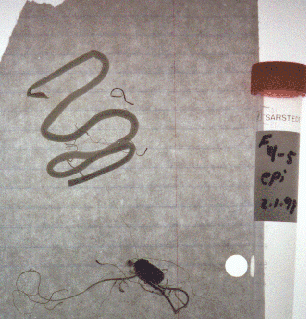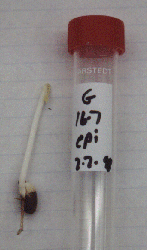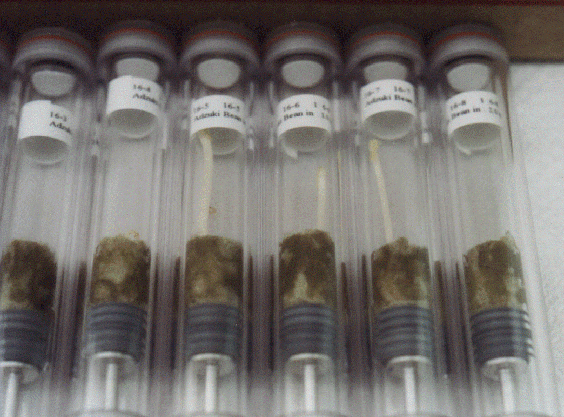NASA/MIR
Space Station ODC™ Test Results
Anti-fungal properties discovered for growing plants without
pesticides
Report to NASA
by BioServe
(located on the campus of the University of Colorado, Boulder, CO)
Report Date: 7/31/98
Mission Report: NASA 6 / Mir Space Station
Subject: Anti-fungal properties of ODC
I. Background
Aeroponics International, formerly EnviroGen, Inc., of Berthoud, Colorado,
has been exploring the elicitation of a plantís own natural defense systems
to fend off fungal pathogen attacks. They place the plant in contact
with a naturally occurring compound that elicits the production of fungal
fighting compounds within the plant. BioServe has been involved in
plant growth experiments in space almost since the Centerís inception in
1987. Research conducted by BioServe researchers may indicate that seedlings
grown in space develop fewer lignified vascular elements and less lignin
overall (Campbell et al. 1996). Previous research on mung bean sprouts
demonstrated similar results (Cowles et al. 1994). This research indicates
a shift in the plants metabolic pathways. This could be a result
of a number of factors including influences on environmental parameters
induced by the experimental hardware, or potentially part of the gravitropic
sensory and response mechanisms, or, most intriguing, a decrease in mechanical
loading due to the microgravity environment. Based on these and other initial
studies, Aeroponics International is interested how the hypothesized shift
in metabolic pathways would affect the elicitation of the antifungal response
during space flight. This interest is both to better understand the
underlying mechanisms of the elicitation as well as the applicability of
this technology for use in future advanced life support food production
systems for long term space missions.
II. Objective / Hypothesis
The objective of this experiment was to determine whether or not the
antifungal response of the plants was maintained during spaceflight. Of
even greater interest is whether or not Aeroponic Internationalís elicitor
induced the same response on plants grown in space as it did for plants
on the ground. The hypothesis is that plants grown in space, with and without
the elicitorís influence, will show greater production of antifungal compounds.
III. Results
Along with the experiments that were conducted aboard Mir during NASA
6, concurrent ground control experiments were conducted at SpaceHab in
Cape Canaveral, Florida. Adzuki beans were selected as the test subject
due to slower growth characteristics than Mung beans providing higher mission
success probability in the event of return mission delays. The experiment
included untreated controls as well as the treated experiments with varying
elicitor levels to investigate dose responses of the plants in the two
different gravitational environments. Most of the seedlings were returned
alive to Earth and have undergone biochemical assay to determine the extent
of the elicitation. One set of seedlings was fixed on orbit and is undergoing
further analysis to determine differences in plant structure and the effect
of low gravity on the gravisensing cells (statocytes) of the treated and
control seedlings.
In general the seeds sprouted quite well both on Earth and onboard Mir.
The Mir-grown seedlings tended to exhibit more growth than those grown
on Earth. Though no fungal challenge was intentionally introduced
into the plants, we did see fungal infection of several of the seedlings.
Preliminary visual analysis indicated that the seedlings that were pretreated
with the elicitor exhibited less fungal infection than the untreated seeds.
This was true for both flight and ground experiments. Biochemical
analysis has supported this finding and has further shown these plants
have retained their fungal fighting abilities and the elicitor has maintained
its effectiveness in microgravity. Further analysis is still being
performed on the fixed samples to determine structural differences in the
seedlings.
IV. Conclusions
This experiment suggests that plants can retain their fungal fighting
abilities during growth in microgravity. Further, the elicitation
of antifungal compounds by Aeroponics Internationalís proprietary
elicitor and delivery system exhibits the same dose response both on the
ground and during space flight.
V. Terrestrial applications of the findings
There is tremendous terrestrial application of this technology.
Fungal pathogen infection is a major cause of crop failure around the world.
Widespread use of pesticides raises crop production costs and has potentially
dramatic health concerns. Aeroponics Internationalís elicitor technology
with their unique, patented delivery system can improve food safety and
ground-water quality, as well as reduce farming cost.
This and future studies will help the company perfect its delivery system
for a variety of crops including potatoes, wheat, barley, tomatoes, rice
and soybeans. These experiments are also a potentially important part of
NASAís search for viable strategies to grow food plants on long term space
flights or on future bases on other planets or moons.
VI. Photos
Photos from the Mir Space Station/Kennedy Space Center ODC
Tests
Also see:AeAeroponic Wheat
Test Results
|
Press Release 2/16/98
_______________________________________
Boulder Colorado:
BioServe Space Technologies, a NASA sponsored Commercial
Space Center located at the University of Colorado, Boulder, CO, assisted Aeroponics
International in its efforts to develop an ODC technology for space. BioServe
has flown space payload experiments on 17 shuttle missions and two four-month
Mir missions during the past ten years.
BioServe researcher, Mike Sportiello said today that
astronaut David Wolfe returned back to Earth on January 31st, bringing back
with him Aeroponics International's ODC experiments from the Mir Space Station.
Aeroponics Internationals Organic Disease Control (ODC) experiments on adzuki
beans were the first experiments of their kind to be conducted on food plants
in low-gravity.
Sportiello says that preliminary analysis of the experiments
shows good growth of the adzuki seedlings in low gravity; in addition, seeds
and seedlings treated with ODC appear to have exhibited more robust growth and
disease resistance than those without the ODC treatment.
Further biochemical analysis, to be performed by Dr.
Jim Linden, professor Microbiology and Chemical Engineering, at Colorado State
University, will shed more light on the effect of the ODC treatment on the growth
and disease resistance of the adzuki beans grown on Mir.
Sportiello went on to say that a environmentally benign
method such as Aeroponics International's Organic Disease Control System could
be a valuable advancement both for growing food crops on an ever more populated
Earth and for producing food in non-terrestrial environments as humans
continue to explore the cosmos beyond Earth.
Also see:BioServe
Bulletin: BioServe Links up with Aeroponic International for SBIR
BioServe
Reports ODC Test Results w/ photos:
- ODC treated adzuki beans test
groups out performed the control test groups (in both zero gravity and on
the ground).
- Zero gravity ODC treated adzuki
bean's growth was greater in zero gravity than on the ground.
The GAP housing containing the individual FPAs. The GAP did not receive
any light during its stay on the Mir Space Station. A duplicate experiment
was conducted at Kennedy Space Center (KSC) during the tests on the Mir.
Test data is being compiled by BioServe and Colorado State University.

FPA's containing the individual adzuki bean seeds grown
in low gravity. ODC™ treated adzuki beans
(second from the right to the left). Test control
groups (one and two starting from the right).

Zero gravity grown adzuki bean sprout (treated
with ODC).

Ground experiment showing growth rate of adzuki
bean (treated with ODC™)

Ground experiment showing sprouting adzuki beans (ODC™ treated) vs.
the non treated
controls which failed to emerge.

More ODC / NASA space shuttle results
Related Information:
More info:
NASA SBIR Aeroponic Lettuce Study
NASA/SBIR/Aeroponics International News Release
2/17/98
Denver Post - Business News: Colorado
Firm Tests on the Mir
Space seeds blast off
Pre--flight CSU test results on legumes
Press Release: NASA: Aeroponics International on Russian
Mir Space Station in 1997
Organic Disease Control (ODC)
ODC™ Treatment crop comparison
Recent Article (Jan'97)
ODC/EcoSeed Research Report'96
Press Report June'94
Space Technology Food Production Reference Page
Biocontrol info:
Biocontrol Brochure
BEYOND All Natural Plant Amendmentô Brochure
Testimony Letters
Purchase
ODC / Beyond Biocontrols and Aeroponic Units and Systems
Use natural biocontrol products visit www.aeroponics.com





